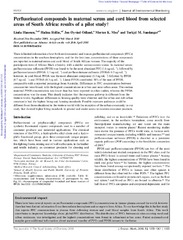Blar i forfatter "Hanssen, Linda"
-
Human biomonitoring of perfluoroalkyl substances and cyclic volatile methylsiloxanes Concentrations in plasma, serum and whole blood from pregnant, delivering or postmenopausal women, and cord blood
Hanssen, Linda (Doctoral thesis; Doktorgradsavhandling, 2013-10-25)Mennesker eksponeres for en rekke miljøgifter gjennom diett og ved bruk av produkter som er ment til å forbedre hverdagen. Kartlegging av eksponering er viktig for å kunne iverksette tiltak som reduserer denne. Vi har undersøkt mengden perfluoroalkyl forbindelser i blodet til fødende kvinner bosatt i Sør Afrika, by beliggende i arktisk del av Russland og landsbygda i Usbekistan. Konklusjonen er at ... -
Kartlegging av miljøgifter i sjøfuglegg fra Sklinna og Røst
Huber, Sandra; Nygård, Torgeir; Warner, Nicholas Alexander; Remberger, Mikael; Harju, Mikael; Uggerud, Hilde Thelle; Kaj, Lennart; Schalbach, Martin; Hanssen, Linda (Research report; Forskningsrapport, 2014)I dette kartleggingsprosjektet ble analysert konsentrasjonene til en lang rekke uorganiske og organiske miljøgifter, som metaller, organotinn, polysykliske aromatiske hydrokarboner, polyklorerte bifenyler og metabolitter, klorerte parafiner, klororganiske pesticider og andre pesticider, per- og polyfluoralkylstoffer, deklorane pluss, oktaklorostyren, organofosfor flammehemmere, bromerte flammehemmere, ... -
Pelagic vs coastal - Key drivers of pollutant levels in Barents Sea polar bears with contrasted space-use strategies
Blévin, Pierre; Aars, Jon; Andersen, Magnus; Blanchet, Marie-Anne; Hanssen, Linda; Herzke, Dorte; Jeffreys, Rachel M.; Nordøy, Erling Sverre; Pinzone, Marianna; de la Vega, Camille; Routti, Heli Anna Irmeli (Journal article; Tidsskriftartikkel; Peer reviewed, 2019-12-11)In the Barents Sea, pelagic and coastal polar bears are facing various ecological challenges that may explain the difference in their pollutant levels. We measured polychlorinated biphenyls, organochlorine pesticides, polybrominated diphenyl ethers in fat, and perfluoroalkyl substances in plasma in pelagic and coastal adult female polar bears with similar body condition. We studied polar bear feeding ... -
Screening new PFAS compounds 2018
Hanssen, Linda; Herzke, Dorte; Nikiforov, Vladimir; Moe, Børge; Nygård, Torgeir; van Dijk, Jiska Joanneke; Gabrielsen, Geir W.; Fuglei, Eva; Yeung, Leo; Vogelsang, Christian; Carlsson, Pernilla Marianne (Research report; Forskningsrapport, 2019)This screening project has focused on the occurrence of conventional andemerging PFASs in terrestrial and marine environments, including the Arctic. Conventional PFASs were found to be wide-spread in the environment and for the first time in Norway reported in wolf, a top predator from the terrestrial environment.Otters living in close proximity to human settlements and preying on the marine food ... -
Targeted PFAS analyses and Extractable Organofluorine – Enhancing our Understanding of the presence of unknown PFAS in Norwegian wildlife
Herzke, Dorte; Nikiforov, Vladimir; Yeung, Leo WY.; Moe, Børge; Routti, Heli Anna Irmeli; Nygård, Torgeir; Gabrielsen, Geir W.; Hanssen, Linda (Journal article; Tidsskriftartikkel; Peer reviewed, 2022-11-17)With the current possible presence of thousands of PFAS compounds in industrial emissions, there is an increasing need to assess the impacts of PFAS regulation of conventional PFAS on one hand and the exposure to emerging and yet unknown PFAS on the other. Today’s analytical methodologies using targeted approaches are not sufficient to determine the complete suite of PFAS present. To evaluate the ... -
Time trends of perfluoroalkyl substances in blood in 30-year old Norwegian men and women in the period 1986–2007
Berg, Vivian; Sandanger, Torkjel M; Hanssen, Linda; Rylander, Charlotta; Nøst, Therese Haugdahl (Journal article; Tidsskriftartikkel; Peer reviewed, 2021-04-11)Biomonitoring studies are helpful tools and can increase our knowledge on time trends in human blood concentrations of PFASs: how they relate to emission trends and the potential prenatal exposure for future generations. In this study, serum was sampled in cross-sections of men and women who were 30 years old in each of the years 1986, 1994, 2001, and 2007 in Northern Norway and analyzed for 23 ... -
Time trends of persistent organic pollutants in 30 year olds sampled in 1986, 1994, 2001 and 2007 in Northern Norway: Measurements, mechanistic modeling and a comparison of study designs
Nøst, Therese Haugdahl; Berg, Vivian; Hanssen, Linda; Rylander, Charlotta; Gaudreau, Eric; Dumas, Pierre; Breivik, Knut; Sandanger, Torkjel M (Journal article; Tidsskriftartikkel; Peer reviewed, 2019-03-01)<p><i>Background</i>: Human biomonitoring studies have demonstrated decreasing concentrations of many persistent organic pollutants (POPs) in years after emission peaks.</p> <p><i>Objectives</i>: To describe time trends of POPs in blood using four cross-sectional samples of 30 year olds from Tromsø, Norway across 1986–2007, and to compare the measured concentrations of polychlorinated biphenyl ...


 English
English norsk
norsk





